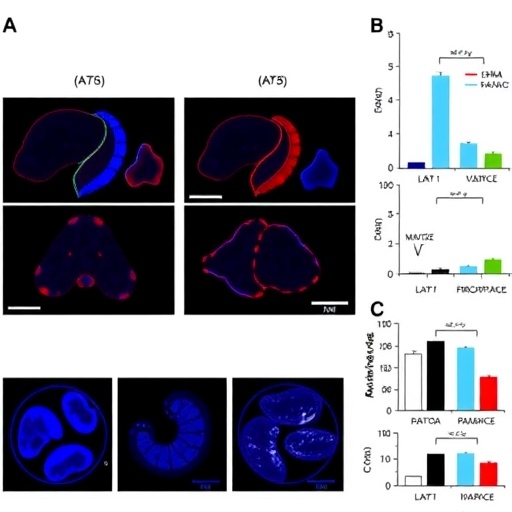
Fucosyltransferase 11 Emerges as a Key Modulator of Ferroptosis in Gastric Cancer through GPX4 Regulation
In the relentless fight against gastric cancer, a lethal malignancy with a notoriously poor prognosis, new molecular insights are shedding light on potential therapeutic avenues. A recent groundbreaking study published in BMC Cancer has unveiled the pivotal role of Fucosyltransferase 11 (FUT11) in modulating ferroptosis, a novel form of programmed cell death, by regulating the expression of the antioxidative enzyme glutathione peroxidase 4 (GPX4). This discovery not only advances our understanding of gastric cancer biology but also offers a promising target for future treatments.
Ferroptosis, distinct from apoptosis and necrosis, is characterized by iron-dependent lipid peroxidation leading to cell death. Unlike other cell death pathways, ferroptosis is initiated by the accumulation of lethal lipid peroxides catalyzed by divalent iron ions. This pathway has recently gained significant attention for its role in controlling cancer cell proliferation and survival. However, the regulatory mechanisms governing ferroptosis in gastric cancer have remained elusive, until now.
Fucosyltransferases, a family of enzymes responsible for transferring fucose sugars to glycoproteins and glycolipids, have been implicated in various aspects of tumorigenesis. FUT11, a relatively understudied member of this family, has been previously noted for its elevated expression across several tumor types. The present study reveals that FUT11 is markedly overexpressed in gastric cancer cells and that this overexpression correlates closely with advanced TNM stage and poor patient outcomes. Such a strong clinical association underscores FUT11 as a potential biomarker for aggressive gastric cancer.
Delving deeper into cellular mechanisms, the researchers employed gene knockdown techniques to reduce FUT11 levels in gastric cancer cell lines. Remarkably, the suppression of FUT11 led to a substantial decrease in cell proliferation, indicating its critical role in sustaining tumor growth. Further molecular analysis uncovered that FUT11 knockdown coincided with a significant reduction in GPX4 protein levels, a paramount defender against ferroptosis. This finding elegantly bridged FUT11 activity with ferroptotic regulation.
GPX4 is a well-recognized suppressor of ferroptosis due to its ability to detoxify lipid peroxides, thereby safeguarding cellular membranes from oxidative damage. The decrease in GPX4 upon FUT11 inhibition triggered enhanced lipid peroxidation, culminating in ferroptotic cell death among gastric cancer cells. This axis reveals a novel survival mechanism whereby FUT11 maintains tumor viability by restraining ferroptosis via GPX4 upregulation.
To further validate the functional relationship, the study introduced GPX4 overexpression in FUT11-deficient cells. This maneuver attenuated the anti-proliferative effects induced by FUT11 knockdown, effectively rescuing gastric cancer cells from ferroptosis. This rescue experiment strongly supports the premise that FUT11 exerts its tumor-promoting effects at least partially through the modulation of GPX4 expression and ferroptotic pathways.
The in vivo relevance of this regulatory circuit was demonstrated through mouse xenograft models, where FUT11 knockdown resulted in significantly impaired tumor growth. As anticipated, the concomitant overexpression of GPX4 in these models mitigated the tumor-suppressive impact of FUT11 inhibition, consolidating the therapeutic implications of targeting this pathway in gastric cancer management.
These findings broaden the landscape of ferroptosis regulation, emphasizing the complexity of glycosylation-related enzymes such as FUT11 in dictating cell fate. The study pioneers a mechanistic link between glycosyltransferases and ferroptotic resistance, deepening our molecular understanding of gastric cancer progression and offering new targets for intervention.
The prospect of targeting FUT11 to sensitize gastric cancer cells to ferroptosis opens a compelling therapeutic window. Given the resistance of advanced gastric tumors to conventional chemotherapy and radiotherapy, exploiting ferroptosis for cancer eradication is a promising strategy. Drugs that inhibit FUT11 or modulate its downstream effectors could re-sensitize refractory tumors to ferroptotic cell death, thus improving patient outcomes.
Moreover, the identification of FUT11 expression levels as a prognostic indicator may refine patient stratification and therapy personalization. Patients exhibiting high FUT11 expression might benefit from combinatory therapies that include agents promoting ferroptosis, potentially overcoming therapeutic resistance and diminishing tumor burden.
Despite these advances, several questions remain for future exploration. The precise biochemical pathways by which FUT11 regulates GPX4 expression remain to be elucidated. Whether FUT11’s role in glycosylation influences GPX4 stability, localization, or enzymatic activity is a fertile area for further biochemical investigation.
Additionally, the broader implications of FUT11-mediated ferroptosis regulation across different cancer types merit investigation. Considering the overexpression of FUT11 in various malignancies, similar mechanisms may be exploited by other tumor cells to evade ferroptotic death, suggesting a generalizable cancer survival strategy.
This research underscores the intricate interplay between cancer metabolism, programmed cell death, and post-translational modifications orchestrated by glycosyltransferases. It also exemplifies how dissecting molecular crosstalk can uncover vulnerabilities exploitable for therapeutic purposes.
Collaboration between molecular biologists, oncologists, and pharmacologists will be essential to translate these findings into clinical practice. The development of specific FUT11 inhibitors or modulators and their testing in preclinical models represent urgent next steps.
Importantly, safety profiles and off-target effects need careful evaluation since fucosyltransferases are involved in diverse physiological processes beyond cancer. Strategies aiming at selective inhibition within tumor cells could mitigate potential adverse effects.
In summary, the discovery of FUT11’s role in restraining ferroptosis via GPX4 upregulation adds a significant piece to the complex puzzle of gastric cancer biology. It provides actionable insights for the design of innovative therapies harnessing ferroptosis to combat this formidable disease more effectively.
As the scientific community continues to unravel the layers of cancer cell survival, targeting glycosylation enzymes like FUT11 offers a novel and exciting front in the war against gastric cancer.
—
Subject of Research: Regulation of ferroptosis in gastric cancer through Fucosyltransferase 11 and GPX4 expression
Article Title: Fucosyltransferase 11 restrains ferroptosis via upregulation GPX4 expression in gastric cancer
Article References:
Zhang, B., Chen, Y., Gu, X. et al. Fucosyltransferase 11 restrains ferroptosis via upregulation GPX4 expression in gastric cancer. BMC Cancer 25, 923 (2025). https://doi.org/10.1186/s12885-025-14340-4
Image Credits: Scienmag.com
DOI: https://doi.org/10.1186/s12885-025-14340-4
Tags: antioxidative enzymes in cancerferroptosis regulation in gastric cancerFucosyltransferase 11gastric cancer prognosisGPX4 expression modulationiron-dependent cell deathlipid peroxidation in cancermolecular insights in gastric cancer researchnovel cancer treatment strategiesprogrammed cell death mechanismstherapeutic targets in oncologytumorigenesis and glycosylation


